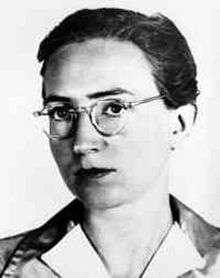Hilde Coppi
Betty Gertrud Käthe Hilda (30 May 1909 – 5 August 1943) was a German resistance member of the anti-fascist resistance group that was later called the Red Orchestra by the Gestapo.[1]

Life
Coppi was born in Berlin, and grew up in Mitte area. Her mother ran a small leather shop. After finishing vocational school, she worked as a language teaching assistant through much of the 1930s.
Hilde Rake was working in Berlin as a clerk at the Reich Insurance Institute for Clerical Workers when she got to know Hans Coppi, who had only just been released from prison. Already by 1933, Rake had had contact with members of the Communist Party of Germany (KPD).
Together, Hilde and Hans Coppi — who wed on 14 June 1941 — hid persecution victims of the Nazi régime. During the war, Hilde Coppi listened to "Voice of Russia" (ie Radio Moscow) and shared the information broadcast over the radio with the Red Orchestra and other resistance groups. She also relayed greetings and any other signs of continued life heard on Radio Moscow from German prisoners of war to their kin. This was especially important, as Nazi propaganda had it that Soviet troops shot their enemies out of hand, and did not take prisoners. Moreover, she busied herself with broadcasting her group's messages through leaflets and stickers. She conducted a sticker campaign against the Nazis' anti-Soviet propaganda exhibition called "Soviet Paradise".
Hilde Coppi and her husband were both arrested on 12 September 1942, along with Hans' parents and brother, and Hilde's mother. Hilde was pregnant by this time, later giving birth to the couple's son at the Berlin Women's Prison on 27 November. On 22 December 1942, her husband was put to death, and Hilde, too, was sentenced to death in the new year, on 20 January. A petition for clemency was made in her case in July, but Hitler refused to grant it. The execution was delayed until August, so that she could nurse her child. On 5 August 1943, Hilde Coppi was beheaded at Plötzensee Prison in Berlin.
Literature
- Gilles Perrault: Auf den Spuren der Roten Kapelle. Rowohlt 1994.
- Rosiejka, Gert: Die Rote Kapelle. „Landesverrat“ als antifaschistischer Widerstand. – Mit einer Einführung von Heinrich Scheel. ergebnisse, Hamburg 1986, ISBN 3-925622-16-0.
- Peter Weiss setzte Hans und Hilde Coppi in seinem autobiographischen Roman '[Die Ästhetik des Widerstands (1975–1981) ein literarisches Denkmal.
- Elfriede Brüning: … damit Du weiterlebst. Neues Leben, Berlin 1949, über die Geburt von Hans Coppi junior. Nemesis – Sozialistisches Archiv für Belletristik
- von Gélieu, Claudia: Frauen in Haft – Gefängnis Barnimstraße; eine Justizgeschichte. Elefanten-Press, Berlin 1994, ISBN 3-88520-530-0. (Nachdruck: Frauen in Haft. Gefängnis Barnimstraße. Eine Justizgeschichte. Espresso-Verlag, ISBN 3-88520-530-0)
See also
- Zentralfriedhof Friedrichsfelde The Socialist Memorial
References
- "Hilde Coppi". Gedenkstätte Deutscher Widerstand. German Resistance Memorial Center. Retrieved 7 September 2019.
External links
- Biography (in German)